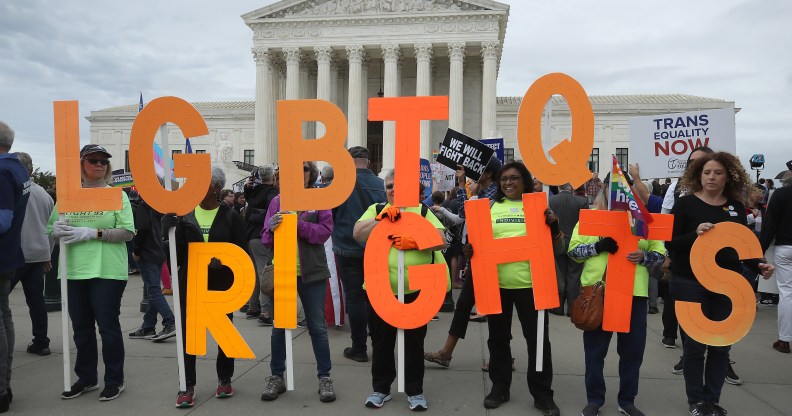Bathrooms came up more than 50 times during the Supreme Court’s landmark LGBT rights hearings

Protesters rallied in front of the US Supreme Court as arguments are heard on the rights of LGBT+ people in the workforce. (Mark Wilson/Getty)
Protesters rallied in front of the US Supreme Court as arguments are heard on the rights of LGBT+ people in the workforce. (Mark Wilson/Getty)
On Tuesday October 8, the US Supreme Court heard three landmark cases that will determine the future of LGBT+ rights in America.
Two of them, Zarda v. Altitude Express and Bostock v. Clayton County, concerned gay men who were fired because of their sexuality, and the third, Stephens v. Harris Funeral Homes, concerned a woman who was fired for being transgender.
The arguments centred on employment discrimination and whether gender identity and sexual orientation are protected under existing federal laws. But somehow, bathrooms became a focal point for the justices.
The Trump administration and lawyers for the employers directed the debate towards the changes that might be required in bathrooms – as well as locker rooms, women’s shelters and school sports teams – if the Supreme Court were to rule in favour of the plaintiffs.
By Mother Jones’ count, the words “bathrooms” and “restrooms” were mentioned a total of 51 times throughout the five-hour hearings.
“Does [your] argument hold up when you get to specific work requirements?” chief justice John Roberts asked David Cole, the attorney representing Stephens.
“In other words, if the objection of a transgender man transitioning to woman is that he should be allowed to use, he or she, should be allowed to use the women’s bathroom, now, how do you analyse that?”

LGBT+ people and allies gathered in front of the US Supreme Court on October 8, 2019 in Washington, DC. (Mark Wilson/Getty)
Supreme Court justice Neil Gorsuch, one of Trump’s controversial judicial nominations, claimed that extending Title VII’s protections to LGBT+ people would trigger “massive social upheaval”.
“As drastic a change in this country as bathrooms in every place of employment and dress codes in every place of employment that are otherwise gender neutral would be changed,” he argued.
Cole quickly shot this down. “First of all, federal courts of appeals have been recognising that discrimination against transgender people is sex discrimination for 20 years. There’s been no upheaval,” he said.
“There are transgender male lawyers in this courtroom following the male dress code and going to the men’s room and the Court’s dress code and sex-segregated restrooms have not fallen.”
Liberal justice Sonia Sotomayor asked how the “genuine need” for transgender people to use bathrooms that correspond with their gender with could be reconciled with (some) women’s discomfort.
“Their need is genuine. I’m accepting all of that,” she said.
“But there are other women who are made uncomfortable, and not merely uncomfortable, but who would feel intruded upon if someone who still had male characteristics walked into their bathroom. That’s why we have different bathrooms. So the hard question is how do we deal with that?”

Anti-LGBT+ protesters made their presence known (Tasos Katopodis/Getty)
She acknowledged that the Civil Rights Act was “born from the desire to ensure that we treated people equally and not on the basis of invidious reasons, and we can’t deny that homosexuals are being fired merely for being who they are”.
Justice Brett Kavanaugh continued to keep his views close to his chest, asking just one question throughout the entire hearing. It was directed to Harris, the attorney arguing on behalf of employers in the sexual orientation cases.
Kavanaugh asked if he was drawing a distinction between the “literal” and “ordinary” meaning of “because of sex” in the context of sex-based discrimination. Harris said he was not.
The Trump administration’s position is that lawmakers never considered gender identity or sexuality when passing Title VII in 1968, so neither of these are protected by the “because of sex” clause in the law.
The Supreme Court is expected to announce its critical ruling on Title VII later this year.

